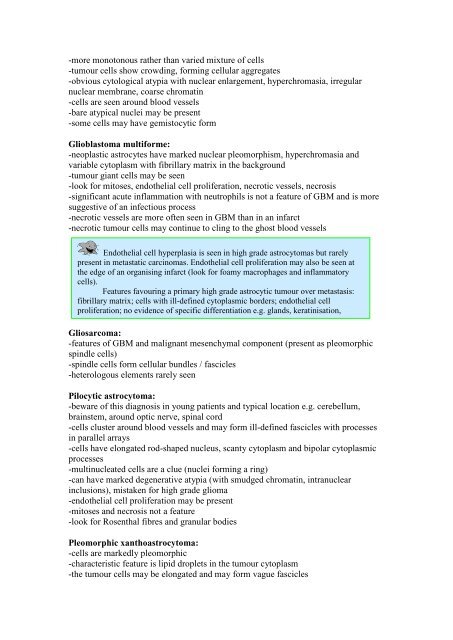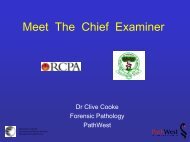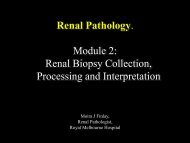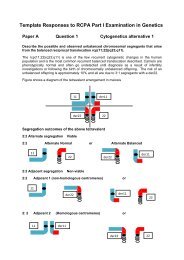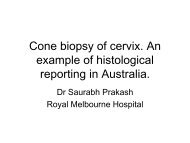CSF/brain smear cytology - Rcpa.tv
CSF/brain smear cytology - Rcpa.tv
CSF/brain smear cytology - Rcpa.tv
- No tags were found...
Create successful ePaper yourself
Turn your PDF publications into a flip-book with our unique Google optimized e-Paper software.
-more monotonous rather than varied mixture of cells-tumour cells show crowding, forming cellular aggregates-obvious cytological atypia with nuclear enlargement, hyperchromasia, irregularnuclear membrane, coarse chromatin-cells are seen around blood vessels-bare atypical nuclei may be present-some cells may have gemistocytic formGlioblastoma multiforme:-neoplastic astrocytes have marked nuclear pleomorphism, hyperchromasia andvariable cytoplasm with fibrillary matrix in the background-tumour giant cells may be seen-look for mitoses, endothelial cell proliferation, necrotic vessels, necrosis-significant acute inflammation with neutrophils is not a feature of GBM and is moresuggestive of an infectious process-necrotic vessels are more often seen in GBM than in an infarct-necrotic tumour cells may continue to cling to the ghost blood vesselsEndothelial cell hyperplasia is seen in high grade astrocytomas but rarelypresent in metastatic carcinomas. Endothelial cell proliferation may also be seen atthe edge of an organising infarct (look for foamy macrophages and inflammatorycells).Features favouring a primary high grade astrocytic tumour over metastasis:fibrillary matrix; cells with ill-defined cytoplasmic borders; endothelial cellproliferation; no evidence of specific differentiation e.g. glands, keratinisation,Gliosarcoma:-features of GBM and malignant mesenchymal component (present as pleomorphicspindle cells)-spindle cells form cellular bundles / fascicles-heterologous elements rarely seenPilocytic astrocytoma:-beware of this diagnosis in young patients and typical location e.g. cerebellum,<strong>brain</strong>stem, around optic nerve, spinal cord-cells cluster around blood vessels and may form ill-defined fascicles with processesin parallel arrays-cells have elongated rod-shaped nucleus, scanty cytoplasm and bipolar cytoplasmicprocesses-multinucleated cells are a clue (nuclei forming a ring)-can have marked degenerative atypia (with smudged chromatin, intranuclearinclusions), mistaken for high grade glioma-endothelial cell proliferation may be present-mitoses and necrosis not a feature-look for Rosenthal fibres and granular bodiesPleomorphic xanthoastrocytoma:-cells are markedly pleomorphic-characteristic feature is lipid droplets in the tumour cytoplasm-the tumour cells may be elongated and may form vague fascicles


